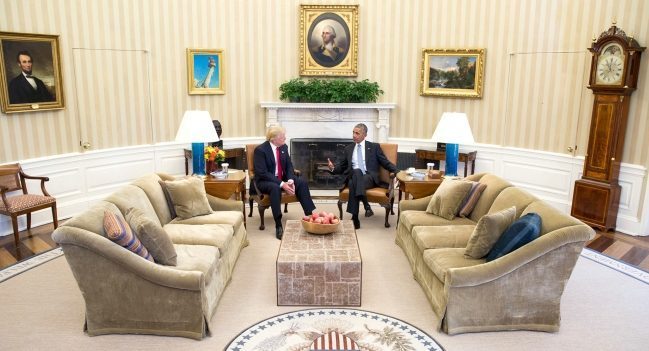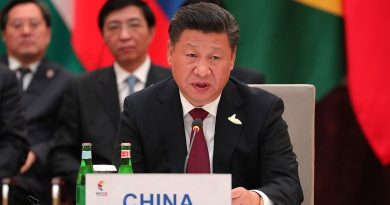The Presidential Transition of Donald Trump
Defying all expectations, Donald Trump’s victory speech was surprisingly conciliatory and gracious, as the President-elect delivered a message of unity that was very much out-of-character, given the negativity of the language commonly used during his campaign. In hopes of determining what line of action will be followed by the erratic future President once he takes office, we look into Mr. Trump’s most prominent post-election statements, and the new developments regarding the Presidential transition.
Post-election statements
A notorious opponent of Obamacare throughout his campaign, the future President has admitted that he will consider keeping two regulations of the Act. However, he shied away from explaining how he would retain them, given his aim of repealing several of its key provisions. When questioned about his Syrian policy, Donald Trump stated that the emphasis would be put on battling ISIS, in detriment of supporting opposition for Moscow ally Bashar al-Assad, as otherwise, the US “would end up fighting Russia.”
Trump also added new caveats to his electoral promises, refusing to confirm the appointment of a special prosecutor to investigate Hillary Clinton, and reducing his previous target of 11 million deportations of illegal immigrants. Although his stance on Roe vs Wade remained unaltered, he now opined that the same-sex marriage question was ‘settled’.
On November 21, the President-elect updated American citizens regarding the policy plans for his first 100 days in office. He highlighted his intent to cancel restrictions on energy production, reduce regulations and lobbying, protect America’s infrastructure, investigate abuses of the Visa Program, and pursue the country’s withdrawal from the Trans-Pacific Partnership.
Trump’s cabinet
When confronted about his lack of government experience during the run for the Presidency, Trump would repeatedly vow to make up for it by surrounding himself with the ‘best people’. While the ousting of Mike Rogers, a leading expert on national security, raised many eyebrows, his replacement by Mike Pompeo, soon to become the new CIA director, was seen as an outstanding pick.
Reince Priebus’ appointment as Chief of Staff has relieved Republican elites, as the long-serving chairman of the Republican National Committee is a Washington insider and close friend of the House Speaker Paul Ryan. His appointment has less popular among Trump loyalists, however. Michael Flynn – who got offered the position of National Security Advisor – is perceived as the “angry voice” of the Alt-Right national security establishment, and one of the most vocal critics of the current American policy against radical Islamic militancy. Jeff Sessions, seen by Trump as the future Attorney General, is an accomplish lawyer who was the first sitting Senator to endorse the President-elect. His pick would seem to rest on the fact that both men share the same anti-immigration views.
Perhaps the most controversial appointment, Steve Bannon was picked as Chief Strategist and Senior Counselor, and will be a “equal partner” to Reince Priebus. Described by Bloomberg as “the most dangerous political operative” in the country, he is the chairman of the Alt-Right website Breitbart News, a vociferous critic of both Democratic and Conservative establishments, and has been accused of selling a white nationalist rhetoric.
Conclusions
Despite his interest in maintaining the two most popular parts of the Affordable Care Act, it is important to remember that the individual mandate, which Donald Trump wants to repeal, was a key condition for insurance companies to accept Obamacare’s regulations. Since without that provision, covering people with preexisting conditions will become fiscally unachievable, it seems more likely that the Act will be completely repealed.
Interestingly, Trump’s update on his Presidential transition left out two of his most important electoral promises – the construction of a wall in the Mexican border and the revocation of Obamacare. Unlike the six policy plans highlighted in that message, those two goals should prove significantly harder to achieve, as they require Congress approval, which might explain their absence. While the Republicans control both the House and the Senate, the majority in the later is incredibly slim and might prove a significant obstacle.
His Syrian policy is also particularly interesting, as it suggests a subordination or alignment of American foreign policy towards Russia’s. His hands-off stance towards Syria would indicate that the future American leader is willing to find a common ground between the two countries. It is likely that we will see lesser involvement from the US in global issues, as Trump’s ‘America First’ stance on foreign policy is put into practice.
As Trump ‘reshuffled’ the Senior White House Transition Team, and Mike Pence replaced Chris Christie’s chairman position, one of the Vice-President-elect’s first moves was the jettison of all the lobbyists in favor of ‘loyalists‘. Despite the message of tranquility that the future President has used to describe his transition, it is clear that a purge is in place.
While for the most part, the cabinet picks accumulate satisfactory experience in government – Bannon being the notorious exception – their appointments should hinder Mr. Trump’s abilities to stay in conformity with the message of unity he voiced during his victory speech. Therefore, as he surrounds himself with individuals that threaten core American values, it becomes difficult to imagine how his alleged goal of a united America can be achieved.
Donald Trump and Barak Obama, Photo by Pete Souza / public domain
![]() This work is licensed under a Creative Commons Attribution-NonCommercial-ShareAlike 4.0 International License.
This work is licensed under a Creative Commons Attribution-NonCommercial-ShareAlike 4.0 International License.




